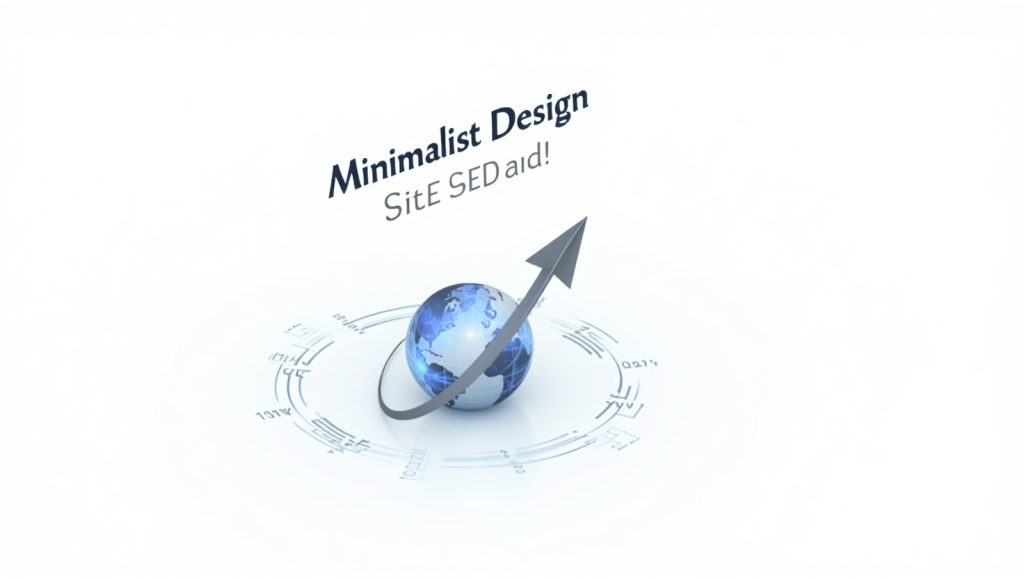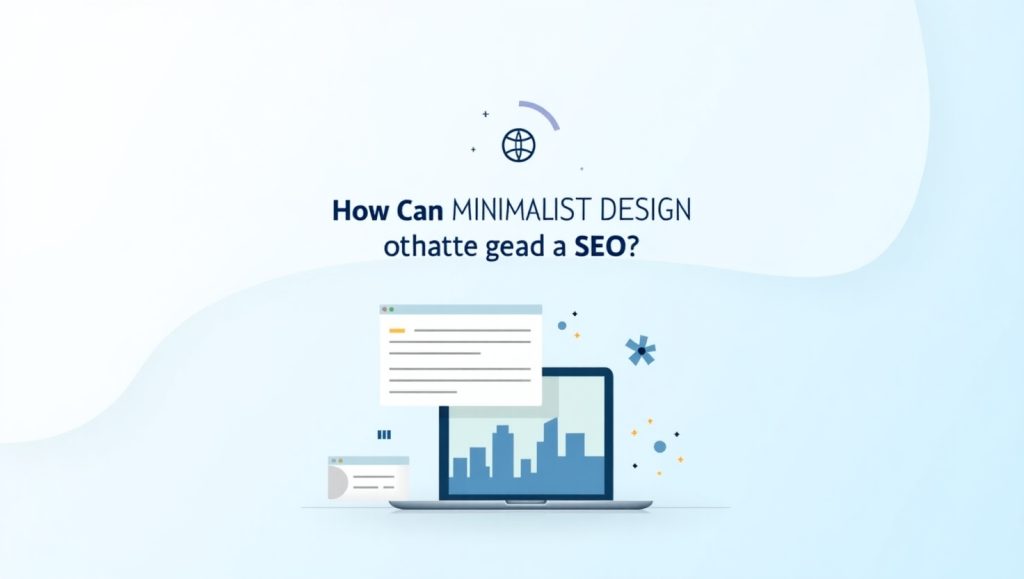Minimalist design is more than a trend—it’s a deeply impactful pattern that can enhance user experience, site speed, and ultimately lead to improved SEO success. While minimalist design can be visually appealing, the true value comes from its ability to simplify your site’s backend and frontend, removing excess digital clutter that leads to slow performance.
In this article, we will look at the meaningful relationship between minimalist design and fast site speed, and how both engage users and relate directly to your SEO result. You’ll also see how minimalist design can positively impact user engagement and technical functions, which are two major elements of a successful website.
Let’s break this down and explore the deeper aspects of minimalist web design.
Less Is More How Minimalist Design Enhances Site Speed

Speed is the most important aspect of website performance. One of the main problems when it comes to slow websites is unnecessary visual clutter—images, videos, sliders, pop-ups, and all the things you don’t need are all taking up valuable resources.
Each of these things is its own element on a webpage. When you are using a simple visual design layout, you are already starting to thin the design down to what is really needed. When you reduce the number of elements on a page, you reduce the code, and ultimately your pages are smaller and lighter because of that. When you strip it down, it is not only a visual choice but a strategic one that improves functionality.
If you can get load times faster, you can reduce bounce rates. Have you ever thought about how often you leave a site just because it takes more than three seconds to load? You’re not alone. Studies show that 40% of users leave a website if they wait longer than three seconds to load. Minimalism will help take care of that.What does minimalist design include?
- Clean layouts
- Flat colors
- Streamlined navigation
- Compressed images
- Lightweight fonts and styles
These elements reduce HTTP requests and file sizes. Fewer scripts and animations also decrease server load, leading to quicker rendering.
By using minimalism strategically, you’re not just making your site prettier—you’re making it faster and more efficient. If you’re working on improving website speed, adopting a minimalist approach can offer instant wins.
This principle is also useful when building mobile responsive websites, where speed matters even more due to network limitations.
Fewer Visual Elements, Better Loading Time
A minimalist website avoids huge hero images, distracting sliders, and animation-heavy designs. This means less weight for each page. Less weight equals faster loading. Using tools like lazy loads and image formats that are optimized for performance (like WebZ), all help performance. Minimalist designs are often already using some of these methods, as minimalist design in its own right is simple, and performance driven.
Let’s view an example in the real world. If you go to a homepage accidentally filled with auto-playing video, five pop-up banners of some sort, and full screen parallax effects, it will even chug along if you have fast internet. If you contrast that with a minimalist site, where there is negative space where appropriate, one clear image, and text where you don’t have to wait for the server to deliver, it’s a different experience. Which would you rather navigate through?
Minimalist websites also generally offer a much better caching experience. With much fewer elements to be saved and delivered, it is easier for the browser to retrieve the saved resources.
Basically, minimalist design is like a digital detox for your website. It strips away the fluff and pushes the content that the user likely wants, much faster.
Minimalist Design and Its Impact on SEO
SEO and minimalist design fit together well. Search engines like Google reward usable, fast loading, and mobile-friendly sites. A minimalist website provides everything search engines like Google prioritize almost naturally. Minimalist sites are made up of fewer components and cleaner code, which makes it easier for search engine bots to crawl and index your website. A cleaner site means more visibility for your content and ultimately a better chance to rank.
Minimalist sites also highlight your core message and keywords. When there are fewer elements, there is less distraction. This helps with readability, engagement, and a lower bounce rate. All metrics that Google uses to rank your page.
Not to mention, Core Web Vitals. These are benchmark indicators of speed and usability that can directly affect your ranking. Minimalist sites typically will fare well on these because they have speed and user experience built into the design.
Minimalism should not be confused with simply doing less. Minimalism is delivering the most valuable content but reducing the amount toward where it is lost behind distracting items that add little value. Its strategic design that supports best practices with search engines.
If you are thinking about hiring an agency to help improve your site performance, you should check out our page on professional WordPress website design.
Improved User Experience Equals Lower Bounce Rate
User experience (UX) is a key factor in SEO. The longer a visitor hangs out on your website, the more search engines consider your site to be valuable.
Minimalist design is a critical piece of the user experience pie. With intuitive navigation, unsophisticated interfaces, and fast-loading pages, users can quickly find what they need; you have decreased frustration and increased the confidence with the search results provided by your website.
Simple site architecture enhances UX for both users and bots. When your web pages have discrete sections with meaningful titles and are linked in a way that follows an expected flow and tempo, users are more likely to engage. If users are finding multiple pages to click on and engage with, search engines consider this engagement to be a signal that your site is valuable to users and, therefore, valuable to the search engine.
For instance, imagine a user lands on your homepage and immediately sees an obvious value proposition, an uncomplicated menu, and fast-loading text and images. Their likelihood to stay on your site as they peruse your blog or services page increases—decreasing the bounce rate and increasing average session time.
A minimalist design is effective because it ensures that nothing gets between your visitor and the action you want them to take—any action: ego or organizational commitment—to do a task (eg. sign up, buy now, or read the latest article on responsive web design strategies).
The SEO Benefits of Fast-Loading Minimalist Websites
Speed is not merely a user choice—it is a ranking factor. In March, 2018, Google officially announced that page speed would impact the rankings of mobile searches. This makes speed a must-have if you want SEO integrity.
Minimalist websites are usually faster! They eliminate bulky code and large assets, add no need for extra plugins or external third-party systems that may be dragging it down, and fundamentally center on speed and accuracy.
With fewer scripts and better-optimized assets your site can be crawled faster and indexed more efficiently by search engines, and thus allowing your pages an edge to rank better.
Speedy websites leave a better first impression. If users have a smooth experience from start to finish when clicking through your site, they will be more likely to return or recommend it to someone.
Remember, SEO is not just keywords – SEO is performance, structure and relevancy. Minimalist websites have all of them.
If you are optimizing your website for search, especially in a competitive market, minimalism should be a primary strategy in your SEO plan.
Mobile Performance and Minimalist Design

More than 60% of internet traffic is now from mobile devices, which means you need your website to work perfectly on small screens—and a minimalist design aids in this.
Minimalist websites load faster and look better on mobile—primarily due to their use of flexible grids, scalable fonts, and fewer elements, as opposed to a denser design that may present obstacles. Minimalism eliminates the barrier that a fully featured mobile experience can create and, as a result, can create friction when mobile browsing.
With Google’s mobile-first indexing everything from your mobile site is the primary version of your website that a search engine spider will consider. So, a cluttered mobile experience may not be favorable for ranking, even if your desktop site is flawless.
Minimalism improves the mobile UX by focusing only on content and methods of interacting. You won’t find yourself pinching to zoom, navigating through complicated mobile menus, or spending hours sifting through unnecessary elements. Everything is simple and accessible.
If you are planning a redesign or working with a web development agency, it is worthwhile to be mindful of minimalism when considering mobile layout.
Conclusion
Websites need to be fast, functional, and focused in today’s digital landscape. Minimalist design offers all of those benefits, and more. Minimalist design removes unnecessary distractions, improves load time, and supports best SEO practices.
When you embrace minimalist design in your website, you offer visitor more than just a better looking website. You are giving your visitors a better performing site, with greater user interaction, and ultimately greater visibility in search engines.
If your site is cluttered with tons of widgets, carousels, and pop-up after pop-up, you may want to consider minimizing what you have. A clean design can change the way your users interact with your site, and how search engines view your site.